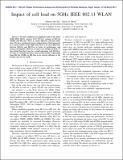Files in this item
Impact of cell load on 5GHz IEEE 802.11 WLAN
Item metadata
| dc.contributor.author | Abu-Tair, Mamoun | |
| dc.contributor.author | Bhatti, Saleem Noel | |
| dc.date.accessioned | 2017-03-31T23:34:01Z | |
| dc.date.available | 2017-03-31T23:34:01Z | |
| dc.date.issued | 2017-03-27 | |
| dc.identifier | 248917846 | |
| dc.identifier | 44aefdd0-71f1-4ec9-ad98-c1fb4709cb65 | |
| dc.identifier | 85019659373 | |
| dc.identifier | 000403401900127 | |
| dc.identifier.citation | Abu-Tair , M & Bhatti , S N 2017 , Impact of cell load on 5GHz IEEE 802.11 WLAN . in 2017 31st International Conference on Advanced Information Networking and Applications Workshops (WAINA) . Institute of Electrical and Electronics Engineers Inc. , PAEWN 2017 - 12th Intl. Wkshp. Performance Analysis and Enhancement of Wireless Networks , Taipei , Taiwan , 27/03/17 . | en |
| dc.identifier.citation | conference | en |
| dc.identifier.other | ORCID: /0000-0002-5566-9997/work/35748042 | |
| dc.identifier.uri | https://hdl.handle.net/10023/10570 | |
| dc.description.abstract | We have conducted an empirical study of the latest 5GHz IEEE 802.11 wireless LAN (WLAN) variants of 802.11n (5GHz) and 802.11ac (Wave 1), under different cell load conditions. We have considered typical configurations of both protocols on a Linux testbed. Under light load,there is no clear difference between 802.11n and 802.11ac in terms of performance and energy consumption. However, in some cases of high cell load, we have found that there may be a small advantage with 802.11ac. Overall, we conclude that there may be little benefit in upgrading from 802.11n (5GHz) to 802.11ac in its current offering, as the benefits may be too small. | |
| dc.format.extent | 176938 | |
| dc.language.iso | eng | |
| dc.publisher | Institute of Electrical and Electronics Engineers Inc. | |
| dc.relation.ispartof | 2017 31st International Conference on Advanced Information Networking and Applications Workshops (WAINA) | en |
| dc.rights | © 2017, IEEE. This work has been made available online in accordance with the publisher’s policies. This is the author created, accepted version manuscript following peer review and may differ slightly from the final published version. The final published version of this work is available at ieeexplore.ieee.org / | en |
| dc.subject | QA75 Electronic computers. Computer science | en |
| dc.subject | TK Electrical engineering. Electronics Nuclear engineering | en |
| dc.subject | NS | en |
| dc.subject | SDG 7 - Affordable and Clean Energy | en |
| dc.subject.lcc | QA75 | en |
| dc.subject.lcc | TK | en |
| dc.title | Impact of cell load on 5GHz IEEE 802.11 WLAN | en |
| dc.type | Conference item | en |
| dc.contributor.sponsor | EPSRC | en |
| dc.contributor.institution | University of St Andrews.School of Computer Science | en |
| dc.date.embargoedUntil | 2017-03-31 | |
| dc.identifier.grantnumber | EP/J016756/1 | en |
This item appears in the following Collection(s)
Items in the St Andrews Research Repository are protected by copyright, with all rights reserved, unless otherwise indicated.

